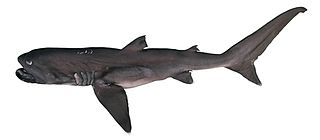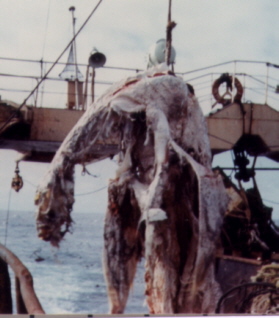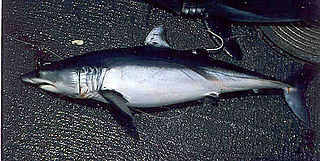
The Cenozoic is Earth's current geological era, representing the last 66 million years of Earth's history. It is characterized by the dominance of mammals, birds, conifers, and angiosperms. It is the latest of three geological eras, preceded by the Mesozoic and Paleozoic. The Cenozoic started with the Cretaceous–Paleogene extinction event, when many species, including the non-avian dinosaurs, became extinct in an event attributed by most experts to the impact of a large asteroid or other celestial body, the Chicxulub impactor.

The megamouth shark is a species of deepwater shark. Rarely seen by humans, it measures around 5.2 m (17 ft) long and is the smallest of the three extant filter-feeding sharks alongside the relatively larger whale shark and basking shark. According to Sharkman's World Organization a total of 286 specimens have been observed or caught since its discovery in 1976, Like the other two planktivorous sharks, it swims with its mouth wide open, filtering water for plankton and jellyfish. It is recognizable from its large head with rubbery lips. The megamouth is so unlike any other type of shark that it is usually considered to be the sole extant species in the family Megachasmidae, though some scientists have suggested it may belong in the family Cetorhinidae.

The basking shark is the second-largest living shark and fish, after the whale shark. It is one of three plankton-eating shark species, along with the whale shark and megamouth shark. Typically, basking sharks reach 7.9 m (26 ft) in length. It is usually greyish-brown, with mottled skin, with the inside of the mouth being white in colour. The caudal fin has a strong lateral keel and a crescent shape. Other common names include bone shark, elephant shark, sailfish, and sunfish. In Orkney, it is called hoe-mother, meaning "the mother of the picked dogfish".

Cetorhinidae is a family of filter feeding mackerel sharks, whose members are commonly known as basking sharks. It includes the extant basking shark, Cetorhinus, as well as two extinct genera, Caucasochasma and Keasius.

The Shark Trust is a charitable organization founded in the United Kingdom in 1997. It is dedicated to promoting the study, management and conservation of sharks, skates and rays (elasmobranchs) in the UK and internationally.

Megachasma is a genus of mackerel sharks. It is usually considered to be the sole genus in the distinct family Megachasmidae, though suggestion has been made that it may belong in the family Cetorhinidae, of which the basking shark is currently the sole extant member. Megachasma is known from a single living species, Megachasma pelagios.

Carcharhinus is the type genus of the family Carcharhinidae, the requiem sharks. One of 12 genera in its family, it contains over half of the species therein. It contains 35 extant and eight extinct species to date, with likely more species yet to be described.

The Zuiyo-maru carcass was a corpse, caught by the Japanese fishing trawler Zuiyō Maru (瑞洋丸) off the coast of New Zealand in 1977. The carcass's peculiar appearance resulted in speculation that it might be the remains of a sea serpent or prehistoric plesiosaur.

Squalodon is an extinct genus of whales of the Oligocene and Miocene epochs, belonging to the family Squalodontidae. Named by Jean-Pierre Sylvestre de Grateloup in 1840, it was originally believed to be an iguanodontid dinosaur but has since been reclassified. The name Squalodon comes from Squalus, a genus of shark. As a result, its name means "shark tooth". Its closest modern relative is the South Asian river dolphin.

Somniosus is a widely distributed genus of deepwater dogfish sharks in the family Somniosidae. Several members of the genus are believed to attain lengths up to 7 m (23 ft), thus ranking among the largest of sharks.

The Ailsa Craig Lighthouse, is an active 19th century lighthouse located on Ailsa Craig, an island in the Firth of Clyde, just offshore from Girvan, South Ayrshire, Scotland.

Sharks continually shed their teeth; some Carcharhiniformes shed approximately 35,000 teeth in a lifetime, replacing those that fall out. There are four basic types of shark teeth: dense flattened, needle-like, pointed lower with triangular upper, and non-functional. The type of tooth that a shark has depends on its diet and feeding habits.

Isurus is a genus of mackerel sharks in the family Lamnidae, commonly known as the mako sharks. They are largely pelagic, fast predatory fish capable of swimming at speeds up to 50 km/h (31 mph).

Carcharias is a genus of mackerel sharks belonging to the family Odontaspididae. Once bearing many prehistoric species, all have gone extinct with the exception of the critically endangered sand tiger shark.

Otodus angustidens is an extinct species of prehistoric megatoothed sharks in the genus Otodus, which lived during the Oligocene and Miocene epochs about 33 to 22 million years ago. The largest individuals were about 11–12 metres (36–39 ft) long. This shark is related to another extinct megatoothed shark, the famous Otodus megalodon.
Basking Sharks were a synthesiser band that formed in 1980 in Lancaster becoming a significant member of the scene in the city and going on to tour in the wider UK. Their music merged power pop with European influences and experimentation and they were notable example of British Indie Synth Pop. Members were Adrian Todd, Ged McPhail and Martyn Eames who used a variety of home-made electronic instruments supplemented by second hand synths that had been customised to provide unique sounds. On stage they always played “live” without the use of backing tracks and their stage act included a slide show, films and computer visuals synced into the stage performance. They produced a single, an EP and an LP, numerous videos, and live recordings. They supported John Peel at a Lancaster gig which prompted him to invite them to record at Maida Vale for his radio show. In 1987 they separated to pursue different projects. Adrian and Martyn formed the industrial technical band Degree 33. Ged moved to Newcastle upon Tyne joining Madam X. Today Adrian and Martyn are working on a new project encompassing old and new technology with a view to live performance and internet release. Ged is developing a recording studio in South Korea. Basking Sharks are still a performing unit but play rarely. A 'best of' CD, Back from the Deep Water was self-released as a CD in 2004 and then re-released in 2019 as an LP and digital download by the Mental Experience label of the Guerssen record label group. A "Basking Sharks" craft beer directly named after the group is also brewed in tribute to them by the Accidental Brewery in Lancaster that now occupies the band's former rehearsal space.

The Keasey Formation is a geologic formation in northwestern Oregon. It preserves fossils dating back to the Paleogene period.
Microcetus is a genus of extinct odontocete from the late Oligocene (Chattian) of Nordrhein-Westfalen, Germany.
Keasius is an extinct genus of basking sharks that lived during the Cenozoic. It contains four valid species, which have been found in North America, Europe, and Antarctica.















